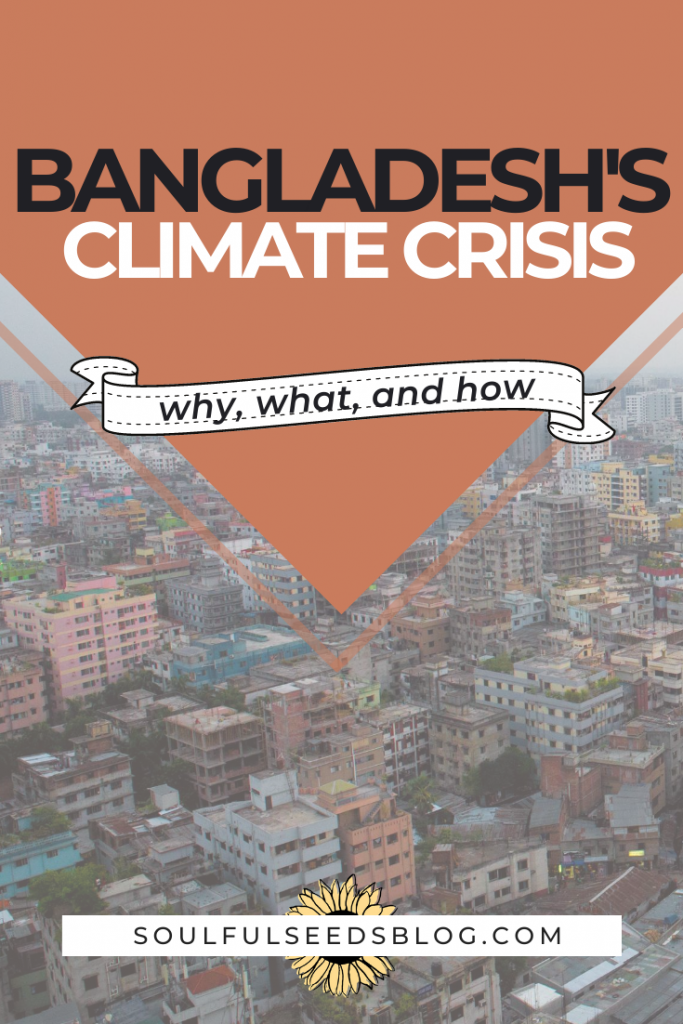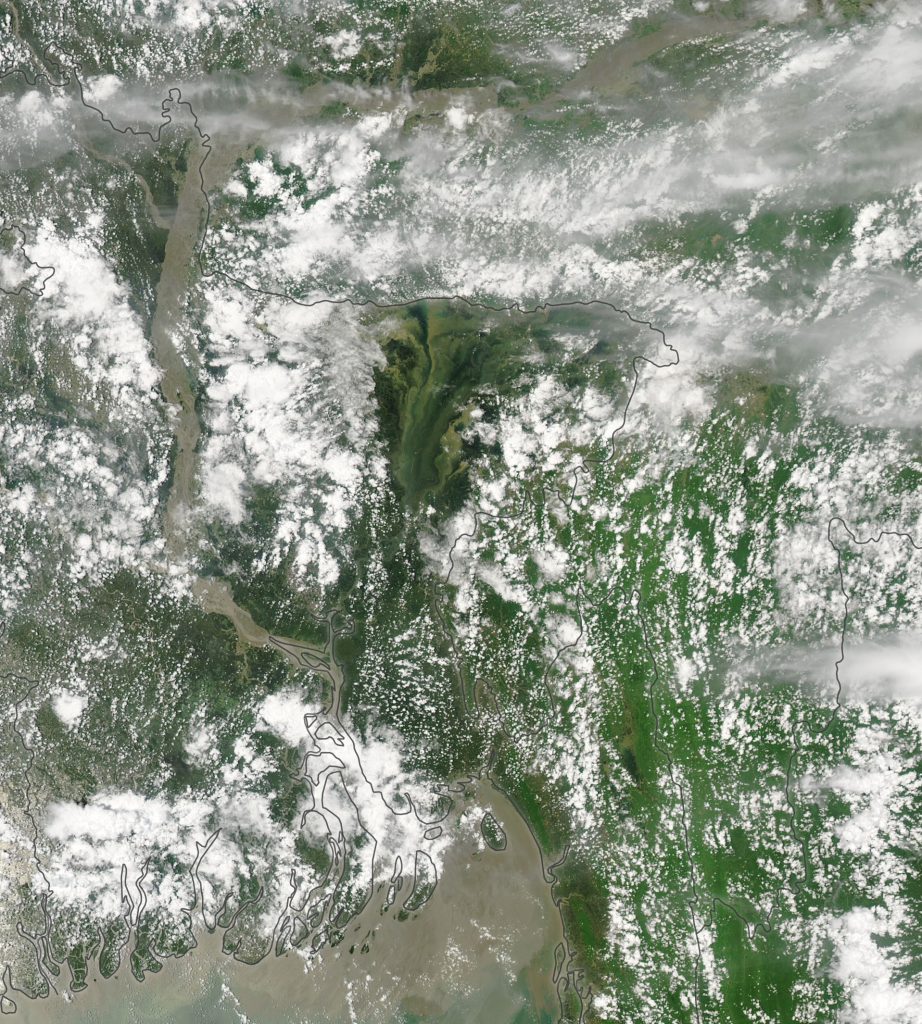Nestled within the Indian subcontinent, Bangladesh is a country of around 164 million people. It is one of the most densely populated countries in the world and lies along the Ganges delta. In the last few months, the country has been ravaged by super-cyclone Amphone followed by one of the most pernicious flood seasons in the last decade.
The low-lying country has long been plagued with flooding, but in the last decade, the frequency and severity of extreme flood and weather events have increased.. and it doesn’t seem like the momentum is slowing down. Climate experts estimate that by 2050, 17% of the nation will be submerged underwater, displacing around 20 million people and causing a 30% decrease in food production. It is widely known that average warming temperatures result in more extreme weather events, especially in areas like South Asia that are already vulnerable to flooding. In 2019, at least 600 people were killed in the South Asian region due to flooding. In 2018, the count was 12 people and in 2017 over 1,000 people across South Asia lost their lives due to flooding.

Not only does flooding threaten to take lives and demolish homes, buildings, and infrastructure, but it also threatens the economy that fuels the country. But it’s not just flooding. Related issues, like saltwater intrusion (the movement of saline water into freshwater aquifers, causing contamination of drinking water and depletion of soil health) wreck havoc on citizens and their livelihoods.
As a result, there have been high levels of migration within the country from coastal areas to urban areas like Dhaka, creating additional climate change problems like air pollution from crowding and urban heat island effect. Estimates point to the urban movement of around 100,000 people each year due to the saltwater flooding. When this is considered in addition to the flow of Rohingya refugees seeking refuge in Bangladesh from the neighboring country of Myanmar, it is evident that the country is overwhelmed with internal and external movement.
Disparity in Climate Contribution
According to the NYT, the average American is responsible for 33 times more carbon dioxide emissions than the average Bangladeshi. This disparity points to the larger phenomenon in the global warming crisis; the Global North contributes the lion’s share of world emissions, but does not reap the consequences of these emissions at the same rate as less responsible countries in the Global South.
A recent study found that the world’s top 10% of income earners are responsible for between 25 and 43% of total emissions, and that the world’s bottom 10% of income earners are responsible for only 3-5% of total global emissions (Scientists’ Warning on Affluence, 2020).
But the consequences of climate change are disproportionately faced by countries like Bangladesh who are less likely to be in the top 10% of income earners globally. Despite being responsible for only 0.3 percent of the emissions that cause global warming, Bangladesh takes 6th place in the Global Climate Risk Index, a list ranking the climate change risk potential for over 180 countries.
Climate Solutions?
Two solutions that have emerged to the increasing vulnerability of floods is 1) replacing the large rice-farming industry with a fishing industry and 2) adapting salt-water resistant crops to the new conditions.
In addition, institutions like the International Monetary Fund (IMF) have compiled a list of ways Bangladesh can institute mitigative strategies to combat the looming climate crisis and the effect it has on the country’s economy. The strategies they recommend include adding a dedicated climate contingency line in budgets, carbon tax on fuel products, and more green investments.
Though these are great frameworks to implement, I believe it is inherently unjust for countries who contribute minimally to climate change to have to bear the brunt of climate change mitigation costs. Countries in the Global South that have high levels of poverty and low per-capita emissions should not have to single-handedly and independently take action that is in a large part caused by countries in the West.
Whose Responsibility?
From a climate justice lens, it is the responsibility of more affluent and emitting countries to help out less-affluent countries who are suffering at higher rates due to rising global emissions.
Countries like the United States need to do more than pass relief packages when large disasters strike. Instead, we should proactively be helping to mitigate the threats that will only increase in the years to come.
The Green Climate Fund was established in 2015 within the framework of the United Nations Framework Convention on Climate Change (UNFCCC). The goal of the fund is to help “developing” countries with efforts to cut carbon emissions and adapt to a rapidly changing climate.
Countries like Australia, Canada, the U.S., and the Netherlands have since failed to maintain their commitments while others, like Germany, the UK, France, Norway, and Sweden have doubled their commitments.
Tragically (but not surprisingly), Donald Trump has revoked President Obama’s commitment to contribute to the fund. When you head to the ballots in November (to all the Americans out there), know that you are voting for the preservation or destruction of our planet!
We must re-sign the Paris Climate Agreement and contribute to the Green Fund and will not be able to do so if Trump returns to office. Read read more about the value of the Green Fund here.
More Info on Bangladesh
If you want to learn more about the crisis in Bangladesh, check out these awesome resources I used for research.
“The Unfolding Tragedy of Climate Change in Bangladesh” by Robert Glennon
“A Quarter of Bangladesh is Flooded. Millions Have Lost Everything.” by Somini Sengupta and Julfikar Ali Manik
“A Climate Migration Crisis is Escalating in Bangladesh” by Adam Wernick
Let me know your thoughts, comments, and questions in the comment section!


Pingback: เครื่องกรองน้ำ coway
Pingback: พิมพ์กล่องกระดาษแพคเกจจิ้ง
Pingback: sahabat kartu
Pingback: bergara 300 prc
Pingback: dumps shop
Pingback: pico laser
Pingback: Buy 5-MeO-DMT (Cartridge and Battery) Perth
Pingback: bonanza178
Pingback: bonanza 178
Pingback: ทดลองเล่นบาคาร่าฟรี
Pingback: บาคาร่าออนไลน์
Pingback: หวยลาว
Pingback: http://www.blackhatlinks.com/generic_keyword_anchor_list.php